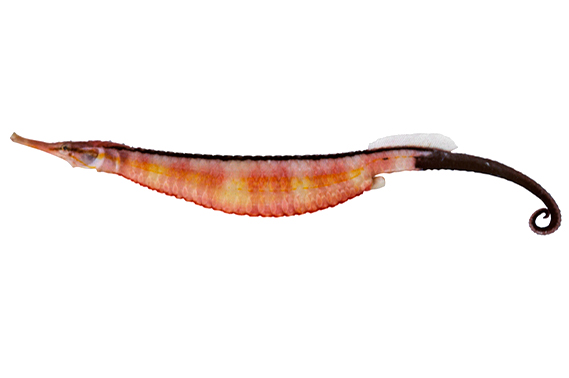Duncker's Pipehorse, Solegnathus dunckeri Whitley 1927

Duncker's Pipehorse, Solegnathus dunckeri, from SE of Brooms Head, New South Wales, 37 m.. Source: Ken Graham / NSW Fisheries. License: All rights reserved
A pale to brown or blackish pipehorse with a pinkish-orange back bounded by black lines along the superior (upper) ridges of the body, 10-11 pale bands along the back and sides, and black markings along the underside of the tail.
Duncker's Pipehorse, Solegnathus dunckeri Whitley 1927
More Info
|
Distribution |
Endemic to eastern Australia from off Fraser Island, Queensland, to at least Forster, and perhaps as far south as Ulladulla, New South Wales; also Lord Howe Island in the Tasman Sea. Inhabits reefs in association with gorgonian corals, black corals, algae or sponges. |
|
Features |
Dorsal fin 16-20; Anal fin 2-3; Pectoral fin 10-13; Trunk rings 14; Tail rings 31-36. Head length 9.6-14.7 in SL; short snout, snout length 3.0-4.4 in head length; snout depth 1.8-3.1 in snout length; median dorsal snout ridge continuous, elevated, the margin denticulate to spinulose posteriorly; eye large. Pectoral fin base low to clearly elevated with entire to minutely serrate margins. |
|
Colour |
Pale to brown or black with 10-11 irregular, diffuse, pale or dark bands on sides and dorsal surface of body, and indications of dark bars on ventral surface of the trunk rings; snout tip often pale in dark specimens. |
|
Feeding |
Preys on small crustaceans. |
|
Biology |
Males brood the pear-shaped eggs embedded in spongy epithelial tissue under the tail. The smallest pregnant male found measured 33.7 cm TL. Males carry between 29 to 120 eggs, and oxygen is supplied to the developing embryos via capillaries in the epithelial tissue. |
|
Fisheries |
Taken as bycatch in commercial trawl fisheries, especially in prawn trawls. Trawled individuals may be exported for sale in the Traditional Chinese Medicine Industry. |
|
Conservation |
Australian Government Legislation: Marine listed under the Environment Protection and Biodiversity Conservation Act 1999. IUCN Red List: Data Deficient |
|
Remarks |
. |
|
Similar Species |
H. dunckeri is most similar to H. boothae but has lower numbers of tail rings (31-36 versus 37-42) and attains a smaller size (120 mm SL versus at least 165 mm in H. boothae). |
|
Etymology |
The species is named in honour of Dr. Georg Duncker, the author of many valuable papers on the family Syngnathidae. |
|
Species Citation |
Solegnathus dunckeri Whitley 1927, Records of the Australian Museum 15(5): 294, pl. 24(1). Type locality: Lord Howe Island. |
|
Author |
Bray, D.J. & Thompson, V.J. 2020 |
|
Resources |
Duncker's Pipehorse, Solegnathus dunckeri Whitley 1927
References
Allen, G.R., Hoese, D.F., Paxton, J.R., Randall, J.E., Russell, B.C., Starck, W.A., Talbot, F.H. & Whitley, G.P. 1976. Annotated checklist of the fishes of Lord Howe Island. Records of the Australian Museum 30(15): 365-454 figs 1-2
Bowles, D.R.J. 2001. The nature of the bycatch fishery of Solegnathus spp. (Pipehorses) in NSW demersal trawl fisheries. Report to NSW Fisheries Scientific Committee.
Bowles, D.R.J. & Martin-Smith, K.M. 2003. Catch and trade of Solegnathus spp. (Pipehorses) from demersal trawl fishery landing sites in New South Wales and Victoria (Australia). Unpublished report, Project Seahorse.
Connolly, R.M., Cronin, E.R. & Thomas, B.E. 2001. Trawl bycatch of syngnathids in Queensland: catch rates, distribution and population biology of Solegnathus pipehorses (seadragons). School of Environmental and Applied Sciences, Griffith University, Gold Coast.
Dawson, C.E. 1982. Synopsis of the Indo-Pacific genus Solegnathus (Pisces : Syngnathidae). Japanese Journal of Ichthyology 29(2): 139-161 figs 1-8
Dawson, C.E. 1985. Indo-Pacific Pipefishes (Red Sea to the Americas). Ocean Springs (Mississippi) : Gulf Coast Research Laboratory 230 pp. 293 figs pl. 1.
Francis, M.P. 1993. Checklist of the coastal fishes of Lord Howe, Norfolk, and Kermadec Islands, Southwest Pacific Ocean. Pacific Science 47(2): 136-170.
Grant, E.M. 1975. Guide to Fishes. Brisbane : Queensland Government, Co-ordinator General’s Department 640 pp.
Hamilton, H., Saarman, N., Short, G., Sellas, A.B., Moore, B., Hoang, T., Grace, C.L., Gomon, M., Crow, K. & Simison, W.B. 2016. Molecular phylogeny and patterns of diversification in syngnathid fishes. Molecular Phylogenetics and Evolution 107: 388-403 + supplement 1-4 + 5. https://doi.org/10.1016/j.ympev.2016.10.003
Johnson, J.W. 1999. Annotated checklist of the fishes of Moreton Bay, Queensland, Australia. Memoirs of the Queensland Museum 43(2): 709-762.
Johnson, J.W. 2010. Fishes of the Moreton Bay Marine Park and adjacent continental shelf waters, Queensland, Australia. pp. 299-353 in Davie, P.J.F. & Phillips, J.A. Proceedings of the Thirteenth International Marine Biological Workshop, The Marine Fauna and Flora of Moreton Bay. Memoirs of the Queensland Museum 54(3)
Kuiter, R.H. 2000. Seahorses, Pipefishes and Their Relatives. Chorleywood, UK : TMC Publishing 240 pp.
Kuiter, R.H. 2009. Seahorses and their relatives. Seaford, Australia : Aquatic Photographics 331 pp.
Martin-Smith, K.M. & Vincent, A.C.J. 2006. Exploitation and trade of Australian seahorses and their relatives (syngnathids). Oryx 40(2): 141-151.
Martin-Smith, K.M., Lam, T.F.-N. & Lee, S.K.-H. 2003. Trade in Pipehorses Solegnathus spp. for Traditional Medicine in Hong Kong. Traffic Bulletin 19: 139–148.
Paulus, T. 1999. Family Syngnathidae. pp 2264-2276, In Capenter K.E. & Niem V.H. (eds) The Living Marine Resources of the Western Central Pacific. FAO Species Identification Guide For Fisheries Purposes. FAO Vol. 4. pp 2069-2790.
Pogonoski, J.J., D.A. Pollard & J.R. Paxton. 2002. Conservation Overview and Action Plan for Australian Threatened and Potentially Threatened Marine and Estuarine Fishes, Environment Australia, Canberra. 375 pp.
Pollom, R. 2017. Solegnathus dunckeri. The IUCN Red List of Threatened Species 2017: e.T20314A67623372. http://dx.doi.org/10.2305/IUCN.UK.2017-2.RLTS.T20314A67623372.en. Downloaded on 31 July 2018.
Whitley, G.P. 1927. Studies in Ichthyology No. 1. Records of the Australian Museum 15(5): 289-304 fig. 1 pls 24-25 https://doi.org/10.3853/j.0067-1975.15.1927.816
Whitley, G.P. 1929. Additions to the checklist of the fishes of New South Wales No. 2. The Australian Zoologist 5(4): 353-357
Whitley, G.P. 1966. Marine Fishes of Australia. Brisbane : Jacaranda Press Vol. 1 pp. 1-142.
Whitley, G.P. & Allan, J. 1958. The Sea-horse and its Relatives. Melbourne : Georgian House 84 pp. 25 figs.

